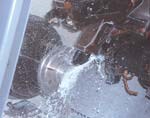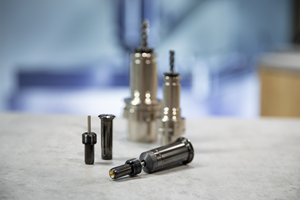Coolant Solves Odor And Dermatitis Problems
Unfortunately, along with this shop's successful growth rate came some new problems, the same problems experienced by many other companies: coolant odor, dermatitis outbreaks and rust.
Converse Industries (Kenosha, Wisconsin) is a rapidly growing specialty machining company. Quality control, combined with ultra precision CNC milling and turning, led the company to a growth rate of more than 33 percent last year. Converse achieved this increase in production by investing in automated multi-tasking equipment. These investments have also helped to prepare the company for future growth. In addition, ISO 9000 certification has enhanced the company's position in serving industries including aerospace, defense, motorcycle, automotive, medical instrumentation, and more.
Unfortunately, along with this successful growth rate came some new problems, the same problems experienced by many other companies: coolant odor, dermatitis outbreaks and rust.
The company prides itself on keeping a quality environment for its workers. However, although Converse practiced good coolant management, the company still experienced coolant odor issues. When the coolant odor began to become a daily problem, Converse tried several potential solutions. First, the company purchased coalescers and skimmers to control the tramp oil, but the coolant continued to go rancid. When that option failed, the company switched to a conventional semi-synthetic in an attempt to cure the problem. It worked at first, but then the odor came back—not only on Monday mornings, but all the time—even though the concentration was increased several times. Not only did the odor come back, but outbreaks of dermatitis also began to occur among the workers, further aggravating the situation. To top things off, rust began to develop on machine surfaces during down shifts.
Then Mike Bennett, maintenance manager at Converse, learned about the Coolant Manager bacteria control system from Dyna Tech (Pewaukee, Wisconsin). Mr. Bennett contacted Jim Mancos at Dyna Tech to find out if the Coolant Manager ozone generator could help with Converse's dermatitis and coolant odor problems.
Mr. Mancos knew that Coolant Manager would control the odor, but he recognized that bacteria and odor were not the only problems that Converse was experiencing. Switching to the conventional semi-synthetic coolant had resulted in a significant decline in tool life and rust on the machines. In an effort to regain tool life and prevent rust, the use concentration of the coolant had been increased. This increased tool life and controlled the rust to a certain extent, but the use costs went up dramatically and the incidents of dermatitis among the workers began to increase. Although the system could control the odor problem, the dermatitis, rust and concentration problems would still be there.
Mr. Mancos recommended addressing all of the problems by using a new type of cutting fluid: Dyna Cool K2002. This coolant is said to be a high performance product formulated with components resistant to bacteria growth yet gentle to the operator. Though it is a semi-synthetic, it has a high oil content for better lubricity, extended tool life and rust protection. The high oil content leaves a protective oil film on the ways to prevent rust during shutdown periods, an important consideration for CNC machines. These qualities made Dyna Cool K2002 appropriate for Converse's machines. The company could improve the operator acceptance, end the rancid coolant problem, increase tool life, provide the rust protection for its CNC machines and lower use costs by switching to Dyna Cool K2002.
Mr. Bennett decided to test the Dyna Cool K2002. "The operators noticed right away that the coolant didn't smell bad anymore," Mr. Bennett says. He observed that the complaints went away and tool life immediately began to increase.
"Tool life wasn't our main concern," says Mike Straube, turning supervisor. "We wanted to stop the dermatitis and odor, and we also wanted to stop the rust that we started seeing on the machines. The increased tool life was just a bonus."
The decision was made to use this cutting fluid throughout the plant. Since then, dermatitis complaints have disappeared and the rust is gone. Converse has seen an increase in tool life as high as 20 percent, and there is no rancid coolant smell.
It has been almost a year since the switch to this cutting fluid. "Since we switched, we haven't had any more dermatitis or odor complaints," Mr. Bennett says. "In fact, we knew within 2 weeks that we had made the right decision in switching to Dyna Cool K2002."
Mr. Bennett says the company has a simple proportioning system to ensure that adequate concentration is kept in the machines and it keeps its skimmers and coalescers running to control excessive tramp oil. Workers also check their concentrations with a refractometer on a routine basis. Since the cutting fluid is very forgiving, a wide concentration range and a quite a bit of tramp oil can be tolerated without spoiling.
Converse has greatly improved the plant environment by finding an economical solution to the difficult problems of dermatitis, coolant odor and rust, and the improvement has not gone unnoticed. "Since we switched to the Dyna Cool K2002 and the odor is gone, the operators don't mind coming in on Monday mornings," Mr. Bennett says.
Related Content
Henkel Redefines Industrial Machining and Grinding with Sustainable Metalworking Innovation
With innovative formulation and bio-resistant properties, Henkel’s new semi-synthetic lubricant emerges as a pioneering solution in the machining industry.
Read MoreRego-Fix Toolholding System Reduces Coolant Consumption
MQL PG collets are designed for machines using one-channel, internal through-spindle MQL systems.
Read MoreConsiderations for Machining Coolant Care
Coolant care can be simply managed if you know where to pay attention and which hazards to look out for.
Read MoreManaging Coolant with Skimmers, Refractometers and More
Bacteria-infected coolant harms machines and sickens machinists. Coolant management technologies like skimmers and automated systems counter this tendency.
Read MoreRead Next
5 Rules of Thumb for Buying CNC Machine Tools
Use these tips to carefully plan your machine tool purchases and to avoid regretting your decision later.
Read MoreRegistration Now Open for the Precision Machining Technology Show (PMTS) 2025
The precision machining industry’s premier event returns to Cleveland, OH, April 1-3.
Read MoreRego-Fix’s Center for Machining Excellence Promotes Collaboration
The new space includes a showroom, office spaces and an auditorium that will enhance its work with its technical partners.
Read More


























